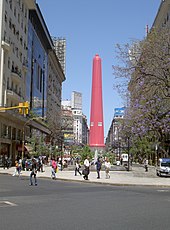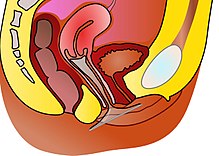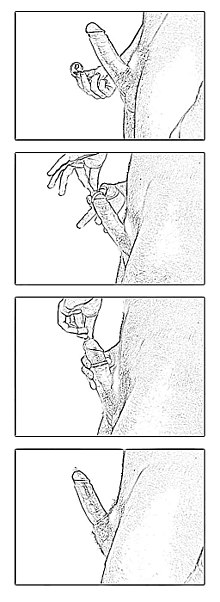安全套:修订间差异
| 第36行: | 第36行: | ||
因為研究樣本存有差異,所以一般使用的懷孕概率的研究結果差異較大,不過一般落在每年10%-18%之間<ref name="Kippley1996">{{cite book | first=John | last=Kippley |author2=Sheila Kippley | year=1996 | title=The Art of Natural Family Planning | edition=4th addition | publisher=The Couple to Couple League | location=Cincinnati, OH | page=146 | isbn=0-926412-13-2}}, which cites: |
因為研究樣本存有差異,所以一般使用的懷孕概率的研究結果差異較大,不過一般落在每年10%-18%之間<ref name="Kippley1996">{{cite book | first=John | last=Kippley |author2=Sheila Kippley | year=1996 | title=The Art of Natural Family Planning | edition=4th addition | publisher=The Couple to Couple League | location=Cincinnati, OH | page=146 | isbn=0-926412-13-2}}, which cites: |
||
:{{cite journal |last=Guttmacher Institute |title=Choice of Contraceptives | journal = The Medical Letter on Drugs and Therapeutics | volume = 34 |pages=111–114 |year=1992|pmid=1448019 |issue=885 }}</ref>。完美使用的懷孕概率則為每年2%<ref name="hatcher" />。避孕套可與其他避孕方式或器具(比如{{link-en|殺精劑|spermicide}})一同使用,以獲得更好的避孕效果<ref name="simultaneous">{{cite journal |author1=Kestelman, P |author2=Trussell, J |title=Efficacy of the simultaneous use of condoms and spermicides | journal = Fam Plann Perspect | volume = 23 | issue = 5 |pages=226–7, 232 |year=1991| pmid = 1743276 | doi = 10.2307/2135759 |jstor=2135759}}</ref>。 |
:{{cite journal |last=Guttmacher Institute |title=Choice of Contraceptives | journal = The Medical Letter on Drugs and Therapeutics | volume = 34 |pages=111–114 |year=1992|pmid=1448019 |issue=885 }}</ref>。完美使用的懷孕概率則為每年2%<ref name="hatcher" />。避孕套可與其他避孕方式或器具(比如{{link-en|殺精劑|spermicide}})一同使用,以獲得更好的避孕效果<ref name="simultaneous">{{cite journal |author1=Kestelman, P |author2=Trussell, J |title=Efficacy of the simultaneous use of condoms and spermicides | journal = Fam Plann Perspect | volume = 23 | issue = 5 |pages=226–7, 232 |year=1991| pmid = 1743276 | doi = 10.2307/2135759 |jstor=2135759}}</ref>。 |
||
===預防性傳播疾病=== |
|||
{{See also|安全性行為}} |
|||
[[File:Condom on Obelisk, Buenos Aires.jpg|thumb|upright|[[布宜诺斯艾利斯方尖碑]]於2005年的[[世界愛滋病日]]被一個巨大的粉紅色避孕套彷製品所覆蓋,目的是為了提高公眾對愛滋病的意識。]] |
|||
避孕套被醫學界廣泛推舉為一種有效預防[[性傳播疾病]]的器具。現有證據已證明其能大大降低性傳播疾病的感染機會,不論使用者的性别。雖然避孕套不能絕對預防性傳播疾病,但卻能大大減低相關病原體的傳播機會,繼使當事人患上[[艾滋病]]、[[生殖器疱疹]]、[[子宮頸癌]]、[[尖锐湿疣]]、[[梅毒]]、衣原體感染以及[[淋病]]等疾病的風險降低<ref name="planned parenthood">{{cite web |title=Condom |publisher=Planned Parenthood | year=2008 |url=http://www.plannedparenthood.org/health-topics/birth-control/condom-10187.htm |accessdate=2007-11-19 }}</ref>。若在避孕之上額外有預防性傳播疾病的需要,醫學界一般建議搭配使用避孕套及其他更有效的避孕方法(比如[[子宮環]])<ref name=DualProtection>{{cite journal|author1=Cates, W. |author2=Steiner, M. J. |year=2002|title=Dual Protection Against Unintended Pregnancy and Sexually Transmitted Infections: What Is the Best Contraceptive Approach?|journal=Sexually Transmitted Diseases|volume=29|issue=3|pages=168–174|url=http://journals.lww.com/stdjournal/Fulltext/2002/03000/Dual_Protection_Against_Unintended_Pregnancy_and.7.aspx|doi=10.1097/00007435-200203000-00007|pmid=11875378}}</ref>。 |
|||
[[美國國立衛生研究院]]於2000年發表的一份報告指出,相對於沒有進行任何保護措施,正確及不間斷地使用乳膠安全套可使愛滋病的傳播風險降低約85%,血清轉換率(感染率)由每100人年(person-years)中的6.7降至0.9<ref name="workshop">{{cite conference|last=National Institute of Allergy and Infectious Diseases |authorlink=National Institute of Allergy and Infectious Diseases |title=Workshop Summary: Scientific Evidence on Condom Effectiveness for Sexually Transmitted Disease (STD) Prevention |pages=13–15 |date=2001-07-20 |location=Hyatt Dulles Airport, Herndon, Virginia |url=https://www.niaid.nih.gov/about/organization/dmid/documents/condomreport.pdf |format=PDF |accessdate=2010-09-22 |deadurl=yes |archiveurl=https://web.archive.org/web/20101009022150/http://www.niaid.nih.gov/about/organization/dmid/documents/condomreport.pdf |archivedate=2010-10-09 |df= }}</ref>。[[世界衛生組織]]和{{link-en|克薩斯大學醫學分部|University of Texas Medical Branch}}同於2007年發表的分析亦有類近的結論:正確及不間斷地使用乳膠安全套可使愛滋病的傳播風險降低約80–95%<ref>{{cite journal|doi=10.1002/14651858.CD003255|author=Cayley, W.E. & Davis-Beaty, K.|year=2007|title=Effectiveness of Condoms in Reducing Heterosexual Transmission of HIV (Review)|publisher=John Wiley & Sons, Ltd. |editor1-last=Weller|editor1-first=Susan C|journal=Reviews}}</ref><ref>{{cite book|author=World Health Organization Department of Reproductive Health and Research (WHO/RHR) & Johns Hopkins Bloomberg School of Public Health/Center for Communication Programs (CCP), INFO Project|year=2007|title=Family Planning: A Global Handbook for Providers| publisher=INFO Project at the Johns Hopkins Bloomberg School of Public Health|url=http://www.infoforhealth.org/globalhandbook/index.shtml|page=200}}</ref>。 |
|||
== 历史 == |
== 历史 == |
||
2017年7月17日 (一) 08:45的版本
| 此條目需要擴充。 (2014年8月15日) |
| 安全套 | |
|---|---|
 一個未展開的男用避孕套 | |
| 背景 | |
| 生育控制種類 | 屏障法 |
| 初次使用日期 | 古代[1] 橡胶避孕套:1855年[2][3] 乳膠避孕套:20世紀20年代[3] 聚氨酯避孕套:1994年 聚異戊二烯合成避孕套:2008年 |
| 懷孕比率 (使用乳膠避孕套後,一年內懷孕概率) | |
| 完美使用 | 2% |
| 一般使用 | 18% |
| 用法 | |
| 注意事項 | 油性潤滑劑會使乳膠避孕套破裂[1] |
| 優點及缺點 | |
| 是否可以防止性傳播疾病 | 是[1] |
| 好處 | 不需要尋求專業醫護人員協助便可使用[1] |

避孕套(英語:Condom,又称安全套、保险套、衛生套,马新地区有时称「如意套」)是一種護套形的屏障器具,主要應用於性交過程中,用以減低感染性傳播疾病和女性懷孕的風險[1]。保險套可細分為女用避孕套和男用避孕套兩種[4]。正確及不間斷地在性交過程中使用男性避孕套,能使該名男性的伴侣的懷孕機率降至每年2%[1]。一般使用的懷孕機率則為每年18%[5]。除此之外,避孕套亦大大降低了淋病、衣原體、滴蟲性陰道炎、乙型肝炎以及艾滋病(HIV/AIDS)的傳播風險,但只能在較少程度上預防當事人感染人類乳突病毒(HPV)、生殖器疱疹以及梅毒[1]。
使用男性避孕套的男性應在性交前把其套到勃起的阴茎上。其避孕原理在於物理性的阻止精液進入性伴侶的體內[6][1]。現代的避孕套的製作材料大多是乳膠,但也有避孕套是利用其他材料製作而成,像是聚胺酯或是羊腸衣[1]。男用避孕套的優點在於價格便宜、容易使用,和少有副作用[1]。乳膠過敏者應選擇非乳膠製的保險套,比如聚氨酯保險套[1]。女用避孕套通常是利用聚氨酯製作而成,並可重複使用[6]。
利用避孕套去預防性傳播疾病的歷史至少可追溯至1564年[1]。橡膠避孕套的首次使用日期為1855年,乳膠避孕套則為20世紀20年代[2][3]。避孕套已被列入世界卫生组织的基本藥品标准清单上,其包含最有效、最安全並能滿足最基本需求的藥物[7]。每個保險套在發展中國家的批發價格約為0.03至0.08美元[8]。在美國每個避孕套的價格一般低於1美元[9]。全球有進行避孕的伴侣当中只有少於10%会使用保險套[10]。已發展國家的人民使用避孕套的比率高於其他國家[10]。避孕套是英國第二常見的避孕措施(22%),美國則是第三常見(15%)[11][12]。全球每年大約有690億個避孕套售出[13]。
用途
避孕
正如其他避孕方式一樣,避孕套的避孕效果可以通過兩個指標來量度:完美使用和一般使用。「完美使用」的量度範圍只包括正確及不間斷地使用避孕套的人群。「一般使用」則量度所有有使用避孕套的人,錯誤使用保險套以及不在每次性交過程都使用避孕套的人群亦計算在内。相關指標一般以一年為單位[14]。大部分研究會以珍珠指数來計算不同避孕方式的效果,但亦有一些研究會以减量表去取代珍珠指数[15]:141。
因為研究樣本存有差異,所以一般使用的懷孕概率的研究結果差異較大,不過一般落在每年10%-18%之間[16]。完美使用的懷孕概率則為每年2%[14]。避孕套可與其他避孕方式或器具(比如殺精劑)一同使用,以獲得更好的避孕效果[17]。
預防性傳播疾病

避孕套被醫學界廣泛推舉為一種有效預防性傳播疾病的器具。現有證據已證明其能大大降低性傳播疾病的感染機會,不論使用者的性别。雖然避孕套不能絕對預防性傳播疾病,但卻能大大減低相關病原體的傳播機會,繼使當事人患上艾滋病、生殖器疱疹、子宮頸癌、尖锐湿疣、梅毒、衣原體感染以及淋病等疾病的風險降低[18]。若在避孕之上額外有預防性傳播疾病的需要,醫學界一般建議搭配使用避孕套及其他更有效的避孕方法(比如子宮環)[19]。
美國國立衛生研究院於2000年發表的一份報告指出,相對於沒有進行任何保護措施,正確及不間斷地使用乳膠安全套可使愛滋病的傳播風險降低約85%,血清轉換率(感染率)由每100人年(person-years)中的6.7降至0.9[20]。世界衛生組織和克薩斯大學醫學分部同於2007年發表的分析亦有類近的結論:正確及不間斷地使用乳膠安全套可使愛滋病的傳播風險降低約80–95%[21][22]。
历史
在前10世紀的古埃及,就已經開始使用羊或豬的膀胱或盲腸等,來做保險套,來防範性病和感染。
在法國一個叫康普利的地方的古老洞穴內,發現約西元2世紀時的保險套壁畫,這是歐陸使用保險套的最早證據。[來源請求]
种类


男用避孕套

由于乳胶是软的,因此男性在使用它的时候必须十分小心,否则容易撕裂。男用避孕套必须在阴茎勃起时才能套到阴茎上。
「ISO 4074」是男用乳膠保險套的國際標準。
女用避孕套
放置在女性阴道内。但由于阻隔了阴道分泌的自然润滑液,所以性交时必须使用润滑液。材质通常为聚亚胺脂,比起一般乳胶套导热性和韧度更好,但价格相对也较高,一般为1.5-2.5美元每片。
口交避孕套
通常用在对男性阴茎口交时使用。材质较薄,表面光滑。同时加有各种香味增加口感,通常会有很多水果口味。
肛交避孕套
肛交安全套材质加厚,其拉伸力是常规避孕套的150%以上。以避免肛交时破裂,需注意是其柔软度较差。
女用隐形避孕套
将泡沫喷入阴道后形成物理阻隔。
女用反强暴避孕套
指險套
進行指交時穿戴在手指上的保險套,可保護受觸部位不被指甲刮傷或細菌感染。
使用方法
男用避孕套必須等到男性勃起後才能套入。
-
古代用动物肠道制作的避孕套。
-
男用避孕套的正确戴法。
-
女用避孕套的放置位置。
材质

乳胶
多数安全套都是用乳胶制成的。但人群中约有8%的人对乳胶过敏而不能使用。現時乳膠製安全套最薄的厚度為0.01mm
聚氨酯
适合对乳胶过敏的人使用。以聚氨酯为材质做的安全套,有较强的韧性和导热性,弹性不及乳胶,像一个塑料袋子。但可做到0.02mm的超薄厚度增加使用者快感。
动物肠道
通常由羊的肠膜或魚鰾所制成,比一般乳胶安全套有更好的导热效果和触感。但只能用来避孕,无法用防止性病和AIDS等感染。公元一千多年前的古埃及就已经使用羊或猪的盲肠来制作安全套了。[23]
参见
參考資料
- ^ 1.00 1.01 1.02 1.03 1.04 1.05 1.06 1.07 1.08 1.09 1.10 1.11 Hatcher, Robert Anthony; M.D, Anita L. Nelson. Contraceptive Technology. Ardent Media. 2007: 297–311. ISBN 9781597080019 (英语).
- ^ 2.0 2.1 Allen, Michael J. The Anthem Anthology of Victorian Sonnets. Anthem Press. 2011: 51. ISBN 9781843318484 (英语).
- ^ 3.0 3.1 3.2 McKibbin, Ross. Classes and Cultures: England 1918-1951. Oxford University Press. 2000: 305. ISBN 9780198208556 (英语).
- ^ WHO Model Formulary 2008 (PDF). World Health Organization. 2009: 372 [8 January 2017]. ISBN 9789241547659.
- ^ Trussell, J. Contraceptive efficacy (PDF). Ardent Media. 2007 [2011-03-13].
- ^ 6.0 6.1 Speroff, Leon; Darney, Philip D. A Clinical Guide for Contraception. Lippincott Williams & Wilkins. 2011: 305–307. ISBN 9781608316106 (英语).
- ^ WHO Model List of Essential Medicines (19th List) (PDF). World Health Organization. April 2015 [8 December 2016].
- ^ Condoms (Lubricated). International Drug Price Indicator Guide. [8 December 2016].
- ^ Shoupe, Donna. Contraception. John Wiley & Sons. 2011: 15. ISBN 9781444342635 (英语).
- ^ 10.0 10.1 Chen, Lincoln C.; Amor, Jaime Sepulveda; Segal, Sheldon J. AIDS and Women’s Reproductive Health. Springer Science & Business Media. 2012: 6. ISBN 9781461533542 (英语).
- ^ Herring, Jonathan. Medical Law and Ethics. Oxford University Press. 2014: 271. ISBN 9780198702269 (英语).
- ^ Daniels, K; Daugherty, J; Jones, J; Mosher, W. Current Contraceptive Use and Variation by Selected Characteristics Among Women Aged 15-44: United States, 2011-2013.. National health statistics reports. 10 November 2015, (86): 1–14. PMID 26556545.
- ^ Hermann, Henry R. Dominance and Aggression in Humans and Other Animals: The Great Game of Life. Academic Press. 2016. ISBN 9780128092958 (英语).
- ^ 14.0 14.1 Hatcher, RA; Trussel, J; Nelson, AL; et al. Contraceptive Technology 19th. New York: Ardent Media. 2007 [2009-07-26]. ISBN 1-59708-001-2. (原始内容存档于May 31, 2008).
- ^ Kippley, John; Kippley, Sheila. The Art of Natural Family Planning 4th addition. Cincinnati, OH: The Couple to Couple League. 1996. ISBN 0-926412-13-2.
- ^ Kippley, John; Sheila Kippley. The Art of Natural Family Planning 4th addition. Cincinnati, OH: The Couple to Couple League. 1996: 146. ISBN 0-926412-13-2., which cites:
- Guttmacher Institute. Choice of Contraceptives. The Medical Letter on Drugs and Therapeutics. 1992, 34 (885): 111–114. PMID 1448019.
- ^ Kestelman, P; Trussell, J. Efficacy of the simultaneous use of condoms and spermicides. Fam Plann Perspect. 1991, 23 (5): 226–7, 232. JSTOR 2135759. PMID 1743276. doi:10.2307/2135759.
- ^ Condom. Planned Parenthood. 2008 [2007-11-19].
- ^ Cates, W.; Steiner, M. J. Dual Protection Against Unintended Pregnancy and Sexually Transmitted Infections: What Is the Best Contraceptive Approach?. Sexually Transmitted Diseases. 2002, 29 (3): 168–174. PMID 11875378. doi:10.1097/00007435-200203000-00007.
- ^ National Institute of Allergy and Infectious Diseases. Workshop Summary: Scientific Evidence on Condom Effectiveness for Sexually Transmitted Disease (STD) Prevention (PDF). Hyatt Dulles Airport, Herndon, Virginia: 13–15. 2001-07-20 [2010-09-22]. (原始内容 (PDF)存档于2010-10-09).
- ^ Cayley, W.E. & Davis-Beaty, K. Weller, Susan C , 编. Effectiveness of Condoms in Reducing Heterosexual Transmission of HIV (Review). Reviews (John Wiley & Sons, Ltd.). 2007. doi:10.1002/14651858.CD003255.
- ^ World Health Organization Department of Reproductive Health and Research (WHO/RHR) & Johns Hopkins Bloomberg School of Public Health/Center for Communication Programs (CCP), INFO Project. Family Planning: A Global Handbook for Providers. INFO Project at the Johns Hopkins Bloomberg School of Public Health. 2007: 200.
- ^ [1],2012-07-11
外部連結
| 维基共享资源上的相关多媒体资源:安全套 |
| ||||||||||||||||||||||||||||||||||||||||||||||||||||||||||||||||||||||||||||||||||||||||||||||||||
| |||||||||||||||||||||||||||||||||||||||||||||||||||||||||||||||||||||||||||||||||
| |||||||||||||||||


